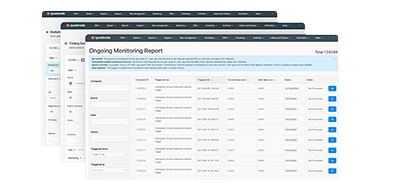Voltar
Contents
O que é Front Running? Um Guia Completo


Vitaly Makarenko
Chief Commercial Officer

Demetris Makrides
Senior Business Development Manager
O que é Front Running?
Front running é a atividade ilegal e antiética de negociar um título com base em informações prévias e não públicas sobre uma transação iminente que provavelmente alterará o preço do título. Em termos simples, são pessoas que possuem informações privilegiadas sobre uma grande ordem iminente e usam essas informações em seu benefício, realizando negociações antes mesmo de seus clientes ou do mercado em geral.
Esta prática alavancas Assimetria informacional que permeia o relacionamento entre profissionais financeiros, como corretores, e seus clientes ou o público investidor em geral. Os pioneiros se aproveitam dessa informação privilegiada para lucrar às custas de seus clientes e comprometer a integridade e a imparcialidade dos mercados financeiros.
O front running contraria os princípios fundamentais da eficiência do mercado e da proteção do investidor. É uma grave violação da responsabilidade fiduciária por parte daqueles que administram dinheiro e ativos pertencentes a terceiros. Portanto, é veementemente denunciado por reguladores, órgãos do setor, bem como por investidores éticos e responsáveis.
Tipos de estratégias de front running
Antecipando grandes pedidos de clientes
Uma das estratégias de front running mais comuns é antecipar o efeito no preço de uma ordem de compra grande e iminente de um cliente. Por exemplo, se um corretor sabe que um cliente fará uma ordem de compra substancial para uma ação específica, ele pode decidir comprar essa ação em sua própria conta antecipadamente. Isso permite que ele se beneficie do aumento subsequente no preço da ação assim que a ordem do cliente for executada e o mercado reagir ao aumento repentino da demanda.
A situação oposta também pode acontecer, na qual um corretor executa uma grande ordem de venda para um cliente, vendendo as ações primeiro para sua própria conta, para que ele possa comprá-las de volta mais tarde a um preço menor, quando a negociação do cliente já tiver derrubado o preço de mercado.
Explorando informações antecipadas sobre eventos que movimentam o mercado
O front running também pode envolver a negociação por indivíduos de informações não públicas sobre notícias ou eventos futuros que provavelmente terão um impacto significativo no preço de um título. Isso pode incluir conhecimento prévio de:
- Anúncios de lucros ou outras notícias da empresa
- Decisões regulatórias ou mudanças de políticas
- Fusões, aquisições ou outras grandes transações corporativas
Ao negociar com base nessas informações privilegiadas antes que elas se tornem públicas, os pioneiros conseguem lucros anormais às custas de investidores desavisados.
Negociação de alta frequência e front running de fundos de índice
O surgimento de negociação de alta frequência (HFT) tem testemunhado o desenvolvimento de novas táticas de front running que alavancam a superioridade tecnológica e as idiossincrasias da estrutura de mercado. Um exemplo dessa estratégia é o chamado front running de fundos de índice, em que empresas de HFT compram ações pouco antes de elas serem incluídas em um índice-chave do mercado, como, por exemplo, o S&P 500.
Quando há um anúncio de adição de um índice, os fundos de índice que seguem o benchmark terão que comprar grandes quantidades das novas ações adicionadas. As empresas de HFT podem tirar vantagem disso comprando rapidamente as ações antes dos fundos de índice, elevando o preço e, em seguida, vendendo para os fundos de índice a um preço mais alto. Embora essa atividade não seja necessariamente ilegal, constitui um uso indevido da superioridade informacional e tecnológica.
Outras técnicas de corrida frontal
Além das estratégias descritas acima, os pioneiros também podem se envolver em práticas manipulativas mais sofisticadas, como:
- Camadas: Colocar grandes ordens de compra ou venda que são rapidamente canceladas, para enganar outros participantes do mercado e desencadear movimentos de preços.
- Falsificação: Enviar ordens sem intenção de executá-las, para induzir outros a negociar em uma direção específica.
- Negociação de lavagem: Executar negociações consigo mesmo ou com um cúmplice para criar uma falsa impressão da atividade do mercado e dos movimentos de preços.
Essas formas mais complexas de front running ilustram ainda mais até onde comerciantes inescrupulosos chegam para obter uma vantagem injusta nos mercados.
Os impactos da corrida na frente
Danos aos investidores individuais
O front running prejudica investidores individuais, pois reduz seu possível retorno sobre o investimento. Quando um front runner abre uma operação antes da ordem do seu cliente, ele está essencialmente "furando a fila" e tirando do cliente a chance de negociar pelo melhor preço. Isso significa que a operação do cliente será realizada em um nível menos desejável, reduzindo seu lucro potencial ou aumentando seu prejuízo.
Com o passar do tempo, o efeito cumulativo dessas operações de front running pode ter um impacto significativo nos retornos gerados por investidores individuais, especialmente aqueles com saldos de conta pequenos e menos resilientes a suportar o impacto. A erosão dos retornos potenciais tem efeitos de longo alcance na capacidade de um indivíduo de poupar, investir e atingir objetivos financeiros.
Distorções nos preços de mercado e liquidez
A prevalência generalizada do front running também cria distorções significativas nos preços de mercado e na liquidez. Quando os front runners agem com base em suas informações, podem causar movimentos de preços abruptos e desproporcionais que não correspondem aos fundamentos subjacentes dos títulos negociados.
Essa incerteza de preço pode interferir na alocação ideal de capital, visto que participantes informados do mercado têm dificuldade em fazer escolhas racionais de investimento diante de tais flutuações artificiais de preço. Além disso, a existência de atividades de front running pode reduzir a liquidez geral do mercado, visto que os investidores temem se envolver em negociações que sejam afetadas negativamente pelo comportamento de perseguição de traders informados.
Consequências econômicas mais amplas
A deterioração da integridade do mercado e da confiança dos investidores, decorrente do front running, tem implicações econômicas mais amplas, que vão além do setor financeiro. Se indivíduos e instituições sentirem que os mercados estão desfavoráveis, terão menor probabilidade de participar, reduzindo assim o capital disponível para investimento no desenvolvimento econômico.
Além disso, a má alocação de capital devido ao front running pode levar a investimentos ineficientes e a uma alocação de capital menos otimizada, o que, por fim, prejudica a produtividade econômica e a inovação. Danos à reputação de mercado também podem prejudicar a capacidade das empresas de levantar capital e financiar suas atividades, restringindo o crescimento econômico e as oportunidades de emprego.
Esforços regulatórios para combater a corrida de frente
Leis de Valores Mobiliários e Regras Antimanipulação
As leis de valores mobiliários e antimanipulação proíbem explicitamente o front running e outras formas de manipulação de mercado. Nos Estados Unidos, a Lei de Valores Mobiliários de 1934 e a Lei Dodd-Frank de Reforma de Wall Street e Proteção ao Consumidor contêm disposições que visam o front running e outras práticas comerciais predatórias.
Na Europa, o Regulamento de Abuso de Mercado (MAR) e a Diretiva de Mercados de Instrumentos Financeiros (MiFID II) introduziram regras rigorosas e penalidades pesadas para indivíduos e empresas considerados culpados de praticar front running ou outras atividades de abuso de mercado.
Supervisão por reguladores financeiros
Para fazer cumprir essas proibições legais, reguladores financeiros como a Comissão de Valores Mobiliários dos EUA (SEC), a Autoridade Reguladora do Setor Financeiro (FINRA) e suas contrapartes em outros países dedicaram recursos significativos para monitorar a atividade do mercado e investigar suspeitas de front running.
Esses órgãos reguladores têm autoridade para impor multas, suspender privilégios de negociação e, em casos extremos, processar criminalmente aqueles que praticaram front running e outras práticas manipulativas. Ações de fiscalização de alto nível, como o caso da SEC contra a corretora Merrill Lynch em 2016, enviaram uma forte mensagem sobre as consequências de tal má conduta.
Soluções Tecnológicas
Além das abordagens legais e regulatórias, o setor financeiro e os formuladores de políticas também têm explorado soluções tecnológicas para lidar com o problema da liderança. Entre elas, estão:
- Sistemas aprimorados de monitoramento e vigilância comercial que podem identificar padrões comerciais suspeitos e alertar os reguladores sobre possíveis atividades de fachada.
- Medidas para reduzir a latência e melhorar a velocidade e a justiça da execução de ordens, como a implementação de "redutores de velocidade" em determinados locais de negociação.
- Tecnologias de contabilidade distribuída, como blockchain, podem aumentar a transparência e reduzir as assimetrias informacionais que permitem o front running.
Embora essas intervenções tecnológicas sejam promissoras, elas também enfrentam desafios para acompanhar as táticas em constante evolução dos pioneiros e outros manipuladores de mercado.
Desafios e Limitações
Apesar das inúmeras medidas regulatórias e tecnológicas para combater o front running, a prática continua prevalente, apontando para as dificuldades e limitações intrínsecas na gestão desse problema complexo.
Uma das principais barreiras é a identificação de estratégias de negociação genuínas em relação ao front running proibido, especialmente no contexto de negociação de alta frequência e outras práticas avançadas de mercado. Os reguladores precisam adaptar continuamente suas técnicas de detecção e permanecer vigilantes a novas variantes de front running.
Além disso, o caráter internacional dos mercados de capitais e os fluxos transfronteiriços de capital podem tornar a aplicação da lei desafiadora, já que os pioneiros podem tentar tirar vantagem de lacunas jurisdicionais ou diferenças regulatórias entre jurisdições.
Considerações éticas e melhores práticas
Responsabilidades fiduciárias dos profissionais financeiros
Planejadores financeiros, corretores e outros participantes do setor têm a obrigação ética e legal de agir no melhor interesse de seus clientes. A obrigação fiduciária exige que eles coloquem os objetivos e as necessidades de seus clientes acima dos seus próprios. Também exige que se abstenham de participar de qualquer ação que possa manchar a integridade do processo de investimento.
O front running constitui um abuso flagrante dessa obrigação fiduciária, com seus conflitos de interesse subjacentes e possibilidades de ganho pessoal às custas dos clientes. Os front runners estão basicamente violando a confiança pública e a confiança do cliente ao se aproveitarem de seus privilégios de informação.
Importância da Transparência e Divulgação
Paralelamente à questão do dever fiduciário, está a exigência de transparência e divulgação completa no setor de serviços financeiros. Os investidores têm o direito de saber como seu dinheiro está sendo administrado e quais as possíveis influências nas decisões de investimento tomadas em seu nome.
Como o front running, por natureza, passa despercebido, sua força reside no sigilo de informações relevantes. Combater tal estratégia exigirá uma ação conjunta para garantir maior transparência por meio de políticas como:
- Fortalecimento das diretrizes de divulgação para consultores financeiros
- Mais relatórios e trilhas de auditoria em negócios comerciais
- Aumento da conscientização e educação do público sobre os riscos do front running
Somente com a elucidação desses processos onerosos o setor financeiro poderá esperar restaurar a confiança dos investidores privados.
Melhorando a justiça do mercado e a proteção do investidor
A iniciativa para eliminar o front running faz parte de um imperativo mais amplo para garantir a justiça e a integridade dos mercados financeiros. Investidores, tanto institucionais quanto individuais, precisam ter confiança de que o jogo está equilibrado e que suas decisões de investimento não estão sendo prejudicadas pelas ações predatórias de insiders bem informados.
Resolver o problema do front running requer uma estratégia multifacetada que vise as estratégias específicas utilizadas por traders antiéticos e as vulnerabilidades estruturais e regulatórias que permitem a ocorrência de tais atividades. Isso pode incluir:
- Fortalecimento das regulamentações antimanipulação e dos regimes de execução
- Melhorar os procedimentos de execução de ordens e minimizar as assimetrias informacionais
- Aumentar a educação e o empoderamento dos investidores
- Promover uma cultura de comportamento ético no setor de serviços financeiros.
Conclusão
O front running representa um grave risco à justiça e à integridade dos mercados financeiros, pois envolve conflitos de interesse em sua própria natureza e está aberto ao enriquecimento de indivíduos em detrimento do público investidor e dos clientes. Como este guia confiável ilustrou, a prática não é limitada, mas sim multifacetada, abrangendo desde corretoras que utilizam vantagens informacionais até traders de alta frequência que alavancam os benefícios da velocidade tecnológica.
FAQ
Os pioneiros exploram sua vantagem informacional executando negociações para suas próprias contas antes de seus clientes ou do mercado como um todo. Isso lhes permite lucrar às custas de seus clientes.
Na negociação, o front running envolve usar conhecimento privilegiado de uma grande ordem pendente para negociar o mesmo título para ganho pessoal, antes que o mercado seja impactado pela negociação do cliente.
A principal diferença está na fonte das informações. O front running envolve a exploração de conhecimento avançado das ordens dos clientes, enquanto o insider trading envolve a negociação com base em informações relevantes não públicas sobre uma empresa ou título.
Atualizado:
20 de fevereiro de 2025




